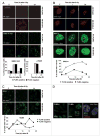Identification of Filamin A as a BRCA1-interacting protein required for efficient DNA repair
- PMID: 20305393
- PMCID: PMC3040726
- DOI: 10.4161/cc.9.7.11256
Identification of Filamin A as a BRCA1-interacting protein required for efficient DNA repair
Abstract
The product of the breast and ovarian cancer susceptibility gene BRCA1 has been implicated in several aspects of the DNA damage response but its biochemical function in these processes has remained elusive. In order to probe BRCA1 function we conducted a yeast two-hybrid screening to identify interacting partners to a conserved motif (Motif 6) in the central region of BRCA1. Here we report the identification of the actin-binding protein Filamin A (FLNA) as BRCA1 partner and demonstrate that FLNA is required for efficient regulation of early stages of DNA repair processes. Cells lacking FLNA display a diminished BRCA1 IR-induced focus formation and a delayed kinetics of Rad51 focus formation. In addition, our data also demonstrate that FLNA is required to stabilize the interaction between components of the DNA-PK holoenzyme, DNA-PKcs and Ku86 in a BRCA1-independent fashion. Our data is consistent with a model in which absence of FLNA compromises homologous recombination and non-homologous end joining. Our findings have implications for the response to irradiation induced DNA damage.
Figures






Comment in
-
Filamins and the potential of complexity.Cell Cycle. 2010 Apr 15;9(8):1463. Epub 2010 Apr 15. Cell Cycle. 2010. PMID: 20421719 No abstract available.
References
-
- Harper JW, Elledge SJ. The DNA damage response: ten years after. Mol Cell. 2007;28:739–45. - PubMed
-
- Falck J, Coates J, Jackson SP. Conserved modes of recruitment of ATM, ATR and DNA-PKcs to sites of DNA damage. Nature. 2005;434:605–11. - PubMed
-
- San Filippo J, Sung P, Klein H. Mechanism of eukaryotic homologous recombination. Annu Rev Biochem. 2008;77:229–57. - PubMed
Publication types
MeSH terms
Substances
Grants and funding
LinkOut - more resources
Full Text Sources
Other Literature Sources
Research Materials
Miscellaneous
